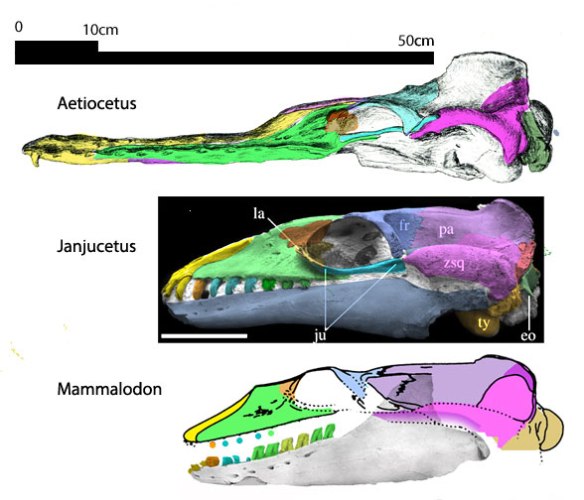According to Wikipedia – Cambaytherium
“Cambaytherium was a genus of herbivorous four-legged quadrupeds.”
That’s about as general as can be imagined.
“Cambaytherium is considered to be close to the ancestry of Perissodactyla, the odd-toed ungulates. An analysis published in 2019 placed the Cambaytheriidae as most closely related to the anthracobunids in the order Anthracobunia, a sister group to the true perissodactyls.”
Confirming those considerations,
in the large reptile tree (LRT, 2319 taxa) Cambaytherium (Fig 1) nests with Anthracobune (Fig 2).
By contrast
those two nest between hippos and desmostylians in the LRT, which puts all these taxa up to their necks in water and apart from the origin of Perissodactyla (= horses and rhinos).

Figure 1. Cambaytherium parts. Colors added here. Here arrows point to bone splinters that are moved back to their invivo positions.
Between the two of them,
Anthracobune and Cambaytherium both provide Bauplans for the missing parts in the other. Using Anthracobune helped restore missing parts and find bone splinters that fill gaps in Cambaytherium (Fig 1).

Figure 3. Anthracobune reconstructed with a larger skull to match the teeth on the mandible.
This is why
you would be wise to revisit your data when things ‘start to gel’ = “to become clearer and more definite, to work well.”
Cambaytherium thewissi
(Rose et al. 2014; Eocene, 55 mya; 45-75 lbs) was originally considered a basal perissodactyl, but nests here with Anthracobune. They both had a posterior mandible with a long retroarticular process. Cambaytherium was found on the marine coastline of island India, close to where pakicetid aand archaeocete whales were convergently evolving from terrestrial tenrec ancestors.
Anthracobune pinfoldi
(Pilgrim 1940; Kumar 1991, middle Eocene, size of a small tapir) The anthracobunids were originally considered proboscideans, like Elephas. Cooper et al. 2014 nested them with perissodactyls, like Ancodus. Here they nest with the mesonychids between Hippopotamus and the desmostylian Paleoparadoxia. Anthracobunids have small and simple upper and lower incisors and relatively small canines. The naris opens dorsally signaling a greater aquatic niche. The retroarticular process is the largest among all mammals. The mandible is longer than the rostrum.

Figure 4. Repairing the apparent mandibular fenestra in the didelphid Ambolestes by shifting a bone splinter.
On a similar notem but on another family tree branch:
and distinct from all other mammals, the didelphid marsupial Ambolestes was preserved with what appears to be a mandibular fenestra (Fig 4). Since no other relatives have such a fenestra, this appears to be due to a displaced splinter of bone replaced to its invivo position here (Fig 4).
References
Cooper LN, Seiffert ER, Clementz M, Madar SI, Bajpai S, Hussain ST, Thewissen JGM 2014. Anthracobunids from the Middle Eocene of India and Pakistan Are Stem Perissodactyls. PLoS ONE. 9 (10): e109232. doi:10.1371/journal.pone.0109232. PMID 25295875.
Cope ED 1873. Fourth notice of extinct Vertebrata from the Bridger and the Green River Tertiaries. Paleontological Bulletin 17:1–4.
Kumar K 1991. Anthracobune aijiensis nov. sp. (Mammalia: Proboscidea) from the Subathu Formation, Eocene from NW Himalaya, India”. Geobios. 24 (2): 221–39. doi:10.1016/s0016-6995(91)80010-w. OCLC 4656806310.
Pilgrim GE 1940. Middle Eocene mammals from north-west Pakistan. Proceedings of the Zoological Society. B. London. 110: 127–152.
Rose, KD et al. (8 other authors) 2014. Early Eocene fossils suggest that the mammalian order Perissodactyla originated in India. Nature Communications. 5 (5570). doi:10.1038/ncomms6570.
Rose KD et al, 2020. Anatomy, Relationships, and Paleobiology of Cambaytherium (Mammalia, Perissodactylamorpha, Anthracobunia) from the lower Eocene of western India, Journal of Vertebrate Paleontology (2020). DOI: 10.1080/02724634.2020.1761370





























